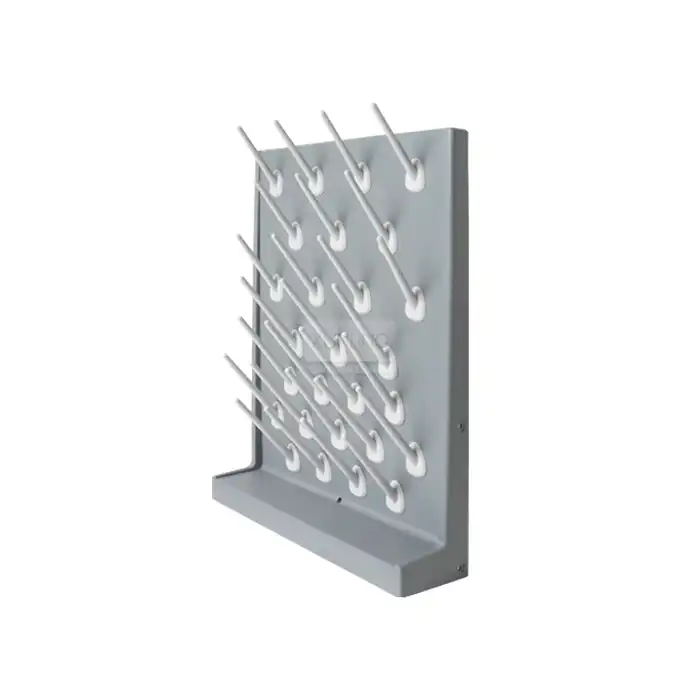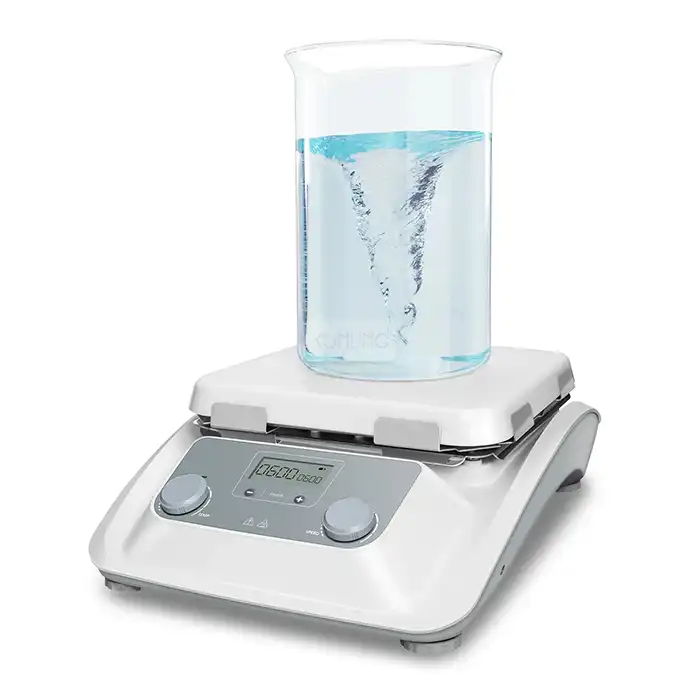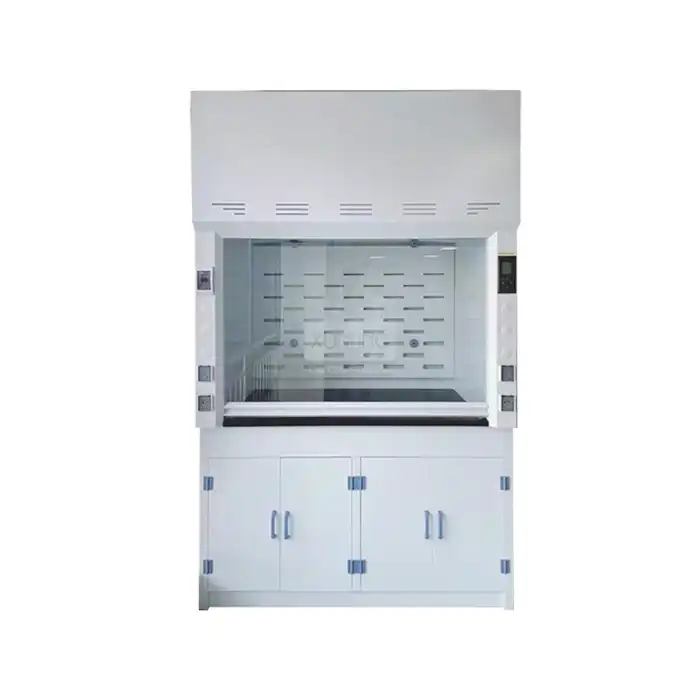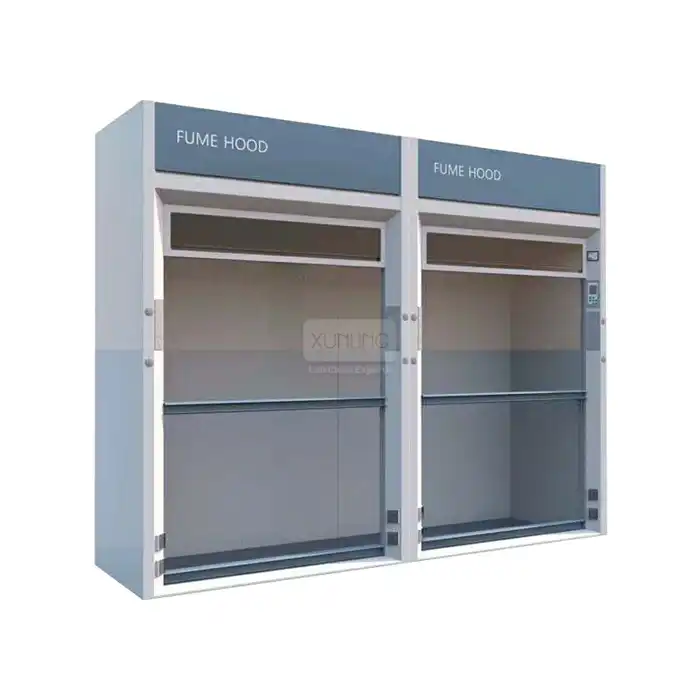
Are polypropylene fume hoods suitable for high-temperature applications?
2025-05-09 15:51:07
Laboratory safety equipment selection requires careful consideration of various factors, including chemical compatibility, durability, and temperature resistance. Polypropylene Fume Hoods have gained popularity in laboratory settings due to their excellent chemical resistance and cost-effectiveness. However, when it comes to high-temperature applications, laboratory managers and safety officers often question their suitability. This article explores whether polypropylene fume hoods can effectively handle high-temperature environments and what limitations they may present.
Polypropylene fume hoods are generally not recommended for high-temperature applications exceeding 80°C (176°F). While these hoods excel in corrosion resistance against acids, bases, and organic solvents, their thermoplastic nature limits their heat resistance. Standard polypropylene begins to soften at approximately 100°C and can deform under sustained exposure to temperatures above 80°C. For laboratories requiring regular high-temperature procedures, alternative materials such as stainless steel, phenolic resin, or specialized high-temperature polypropylene blends may be more appropriate choices. However, for moderate temperature applications with occasional brief heat exposure, properly designed polypropylene fume hoods can still provide safe and effective containment.
Temperature Limitations of Polypropylene Fume Hoods
Heat Resistance Properties of Standard Polypropylene
Polypropylene is a thermoplastic polymer widely used in laboratory equipment manufacturing due to its excellent chemical resistance and cost-effectiveness. However, its temperature resistance presents certain limitations that laboratory managers must consider. Standard polypropylene has a melting point between 160-170°C (320-338°F), but its practical heat resistance is significantly lower. The material begins to soften and may experience deformation at temperatures exceeding 100°C (212°F), and for long-term exposure, the recommended maximum operating temperature is around 80°C (176°F).
The molecular structure of polypropylene contributes to these limitations. As a semi-crystalline polymer, polypropylene consists of both crystalline and amorphous regions. When exposed to increasing temperatures, the amorphous regions begin to soften first, compromising the structural integrity of the polypropylene fume hood. This softening can lead to deformation, warping, or sagging of hood components, potentially compromising the containment function. Additionally, thermal expansion becomes a significant factor at elevated temperatures, potentially causing misalignment of hood components or affecting the sealing properties of the enclosure.
For laboratories that regularly conduct high-temperature procedures, these limitations of standard polypropylene fume hoods can present significant challenges. Continuous exposure to temperatures above the recommended threshold may not only compromise the structural integrity but could also accelerate the aging process of the material, reducing the overall lifespan of the polypropylene fume hood. Therefore, understanding these inherent constraints is crucial when evaluating their suitability for specific laboratory applications.
Thermal Degradation and Performance Impact
When polypropylene fume hoods are subjected to temperatures beyond their recommended operating range, thermal degradation becomes a significant concern. This degradation process involves complex chemical reactions that affect both the physical properties and chemical resistance of the material. The primary mechanism of thermal degradation in polypropylene involves chain scission, where the polymer chains break down into smaller fragments, and oxidation, which introduces oxygen-containing groups into the polymer structure.
The consequences of thermal degradation are multifaceted and can severely impact the performance of polypropylene fume hoods. First, the material may become more brittle, increasing the risk of cracking or failure during normal operation. Second, the dimensional stability of the hood components may be compromised, potentially affecting the airflow dynamics and containment efficiency. Third, thermally degraded polypropylene may exhibit reduced chemical resistance, making it more vulnerable to attack by acids, bases, or solvents that it would normally withstand. This can lead to accelerated deterioration and potential safety hazards in the laboratory environment.
Furthermore, thermal degradation can affect the aesthetic properties of polypropylene fume hoods, causing discoloration (typically yellowing) and surface roughening. While these changes might be considered merely cosmetic, they can serve as visual indicators of material degradation. Laboratory managers should establish regular inspection protocols to identify signs of thermal stress in polypropylene fume hoods, such as discoloration, warping, or changes in surface texture, as these may signal the need for replacement or maintenance to maintain safe operating conditions.
Comparison with Alternative Fume Hood Materials
When considering high-temperature applications, it's essential to compare polypropylene fume hoods with alternative materials commonly used in laboratory environments. Stainless steel fume hoods, particularly those constructed from Type 316 stainless steel, offer superior heat resistance with operating temperatures up to 800°C (1472°F). This makes them ideal for high-temperature processes such as ashing or procedures involving Bunsen burners. However, stainless steel has limitations in applications involving strong acids, particularly hydrofluoric acid, which can corrode the material over time.
Phenolic resin fume hoods present another alternative with better heat resistance than polypropylene fume hoods. These composite materials can typically withstand temperatures up to 150°C (302°F) without significant degradation, making them suitable for moderate-temperature applications. Phenolic resin also offers excellent chemical resistance across a broad spectrum of substances. However, these advantages come at a higher cost compared to polypropylene, and phenolic resin can be more susceptible to physical damage and more difficult to repair than thermoplastic options.
Fiberglass-reinforced plastic (FRP) fume hoods represent a middle ground, offering better heat resistance than standard polypropylene fume hoods with maximum operating temperatures around 120°C (248°F). They combine good chemical resistance with moderate heat tolerance and are particularly suitable for laboratories dealing with corrosive chemicals at elevated temperatures. When selecting between these materials, laboratory managers must carefully assess the specific temperature requirements of their procedures, the chemicals being handled, and budget constraints. For applications requiring occasional high-temperature work, a hybrid approach might be optimal, such as installing heat-resistant work surfaces within a polypropylene fume hood or designating separate hoods for high-temperature and chemical-intensive procedures.
Modified Polypropylene Solutions for Higher Temperature Tolerance
High-Temperature Polypropylene Blends and Composites
To address the temperature limitations of standard polypropylene, manufacturers have developed specialized high-temperature polypropylene blends and composites that significantly enhance heat resistance properties. These modified materials incorporate various additives, fillers, and reinforcing agents that work synergistically to improve thermal stability while maintaining the chemical resistance advantages of conventional polypropylene. Among the most effective modifications is the addition of glass fiber reinforcement, which can increase the heat deflection temperature of polypropylene by 20-40°C, allowing these enhanced polypropylene fume hoods to withstand temperatures up to 120°C (248°F) for short periods.
Another approach involves the incorporation of mineral fillers such as talc or calcium carbonate, which improve dimensional stability at elevated temperatures. These fillers increase the stiffness of the polymer matrix and reduce thermal expansion coefficients, resulting in less warping and deformation when exposed to heat. Some advanced formulations also include nucleating agents that promote the formation of smaller, more numerous crystalline regions within the polypropylene structure, further enhancing temperature resistance.
Polymer blending represents yet another strategy, where polypropylene is combined with higher temperature-resistant polymers like polyphenylene sulfide (PPS) or polyetheretherketone (PEEK) to create hybrid materials with improved thermal properties. These high-performance polypropylene fume hoods offer a compromise between the excellent chemical resistance of standard polypropylene and the superior heat resistance of more expensive engineering plastics. Laboratory managers should carefully evaluate these modified polypropylene options when their applications require both chemical resistance and moderate temperature tolerance, as they may provide a cost-effective solution that eliminates the need for more expensive alternative materials.
Heat-Resistant Coatings and Treatments
Surface modifications offer another approach to enhancing the temperature resistance of polypropylene fume hoods without completely replacing the base material. Specialized heat-resistant coatings can create a protective barrier that shields the underlying polypropylene from direct heat exposure. Ceramic-based coatings, for instance, can withstand temperatures exceeding 200°C (392°F) while providing an additional layer of chemical resistance. These coatings are typically applied through spray techniques or dipping processes and cure to form a durable protective layer that significantly extends the functional temperature range of polypropylene fume hoods.
Surface treatments like flame retardant applications not only improve fire safety but can also enhance heat resistance properties. These treatments typically involve the incorporation of halogenated compounds, phosphorus-based additives, or metal hydroxides that undergo endothermic reactions when exposed to high temperatures, absorbing heat and protecting the underlying polymer structure. Additionally, crosslinking treatments can be employed to modify the molecular structure of polypropylene at the surface level, creating stronger bonds between polymer chains that resist thermal deformation.
The application of reflective finishes represents another effective strategy for managing heat exposure in polypropylene fume hoods. These specialized finishes increase the reflectivity of the surface, reducing heat absorption from radiation sources such as hotplates or heating mantles. When combined with strategic placement of heat shields or deflectors within the fume hood, these surface treatments can create a comprehensive thermal management system that protects vulnerable polypropylene components from excessive heat exposure. Laboratory managers should consider these enhancement options when retrofitting existing polypropylene fume hoods or when specifying new installations for environments where occasional high-temperature procedures are anticipated.
Hybrid Design Solutions
Innovative hybrid designs represent a practical approach to overcome the temperature limitations of polypropylene fume hoods while maintaining their benefits. These designs strategically integrate heat-resistant materials in areas most likely to encounter elevated temperatures while utilizing standard polypropylene in less thermally challenged zones. For example, a common hybrid configuration features heat-resistant work surfaces made from materials like epoxy resin, phenolic composites, or ceramic that can withstand temperatures up to 350°C (662°F), while the hood structure and ducting remain constructed from chemically resistant polypropylene. This targeted approach optimizes both performance and cost-effectiveness without compromising safety.
Modular component systems provide another versatile hybrid solution, allowing laboratories to customize their polypropylene fume hoods according to specific experimental requirements. These systems incorporate interchangeable components that can be swapped based on the temperature profile of different procedures. For instance, removable stainless steel or ceramic work trays can be inserted when conducting high-temperature operations, then removed and replaced with standard polypropylene surfaces for routine chemical handling. Some advanced modular designs even feature double-wall construction with insulating air gaps or thermal barrier materials that significantly reduce heat transfer to the polypropylene structure.
Zoned airflow management represents a sophisticated hybrid approach that uses engineering controls rather than material modifications to address temperature concerns in polypropylene fume hoods. These systems incorporate specialized baffles, additional exhaust ports, or supplementary cooling systems that create microenvironments within the hood. By directing higher airflow to areas with heat-generating equipment, these systems can effectively dissipate thermal energy before it causes material stress to the polypropylene fume hood components. This approach is particularly valuable in laboratories that conduct occasional high-temperature procedures but primarily require the chemical resistance advantages of polypropylene for their day-to-day operations.
Best Practices for Using Polypropylene Fume Hoods with Heat-Generating ProceduresStrategic Equipment Placement and Thermal Management
Effective thermal management begins with strategic equipment placement within polypropylene fume hoods. Heat-generating devices should be positioned to maximize the distance from temperature-sensitive hood components. Elevating hot equipment on ceramic or metal stands creates an air gap that reduces direct heat transfer to the polypropylene work surface. Laboratory managers should establish clear zones within the hood, designating specific areas for heat-generating equipment that are reinforced with appropriate heat-resistant materials. These designated zones should be clearly marked and communicated to all laboratory personnel to ensure consistent compliance with thermal management protocols.
Implementing heat shields represents another crucial strategy for protecting polypropylene fume hoods during high-temperature procedures. Stainless steel or ceramic heat shields can be positioned between heat sources and polypropylene surfaces to block radiant heat and create a protective barrier. These shields should be sized appropriately to cover the entire area potentially affected by heat radiation while allowing sufficient clearance for airflow and operator access. Some advanced shield designs incorporate reflective surfaces that direct heat away from sensitive components or feature integrated cooling fins that enhance heat dissipation through increased surface area.
Supplementary cooling systems can significantly extend the temperature range in which polypropylene fume hoods can safely operate. Localized cooling options include small fans directed at hot spots, water-cooled heat exchangers for particularly intense heat sources, or even compressed air cooling for precision temperature control. These systems should be carefully integrated with the fume hood's existing airflow patterns to avoid disrupting containment efficiency. For laboratories that regularly conduct high-temperature procedures in polypropylene fume hoods, investing in automated temperature monitoring systems with alarm capabilities provides an additional layer of protection by alerting operators when temperatures approach critical thresholds for the polypropylene material.
Workflow Optimization for Temperature-Sensitive Environments
Developing standard operating procedures (SOPs) specifically tailored for high-temperature work in polypropylene fume hoods is essential for maintaining both safety and material integrity. These procedures should clearly outline temperature thresholds, cooling requirements, and equipment handling protocols. Time-based guidelines are particularly important, specifying maximum duration for procedures at different temperature ranges and establishing mandatory cooling periods between high-temperature operations. Comprehensive SOPs should also include emergency protocols for responding to overheating incidents, such as equipment malfunctions or unexpected exothermic reactions, with clear instructions for safely terminating procedures and cooling affected areas.
Staff training programs focused on temperature awareness create a foundation for responsible use of polypropylene fume hoods. These programs should emphasize the temperature limitations of polypropylene materials, train personnel to recognize early signs of thermal stress, and provide practical instruction on implementing thermal management strategies. Hands-on training with thermal imaging cameras or temperature indicators can be particularly effective in developing personnel's ability to assess thermal conditions within the fume hood environment. Regular refresher training ensures that all laboratory staff maintain the necessary knowledge and skills for safe operation, especially in facilities with high turnover or where high-temperature procedures are performed infrequently.
Implementing a comprehensive monitoring and documentation system enables laboratories to track thermal exposure over time and evaluate the cumulative effects on polypropylene fume hood components. This system should include regular temperature mapping of hood surfaces during representative procedures, documentation of duration and frequency of high-temperature operations, and scheduled inspections for signs of thermal degradation. By analyzing this data, laboratory managers can identify potential issues before they become critical and develop more effective strategies for extending the service life of polypropylene fume hoods in mixed-temperature environments. This evidence-based approach to thermal management allows laboratories to strike an optimal balance between utilizing the chemical resistance benefits of polypropylene and accommodating necessary high-temperature procedures.
Maintenance and Inspection Protocols
Regular maintenance and inspection protocols are crucial for identifying early signs of thermal stress in polypropylene fume hoods exposed to elevated temperatures. A comprehensive inspection schedule should include weekly visual checks for discoloration, warping, or crazing of polypropylene surfaces, particularly in areas near heat-generating equipment. Monthly mechanical evaluations should assess the structural integrity of hood components, checking for brittleness, deformation, or changes in flexibility that might indicate thermal degradation. These inspections should be documented using standardized assessment forms that track changes over time, allowing for trend analysis and proactive intervention before critical failures occur.
Implementing a preventive maintenance schedule specifically designed for temperature-challenged polypropylene fume hoods can significantly extend their operational lifespan. This maintenance regimen should include periodic replacement of components most vulnerable to thermal stress, such as work surfaces, baffles, or exhaust connections, even if they haven't yet shown visible signs of degradation. Applying heat-resistant coatings or treatments may need to be refreshed at regular intervals to maintain their protective properties. Additionally, airflow patterns should be recalibrated and verified quarterly to ensure that thermal management strategies remain effective and that containment performance meets safety standards despite potential subtle changes in hood geometry due to thermal cycling.
Documentation and record-keeping form the foundation of an effective maintenance program for polypropylene fume hoods used in temperature-variable environments. Detailed maintenance logs should record all inspections, repairs, and component replacements, along with observations about operating conditions and temperature exposures. These records provide valuable information for evaluating the long-term performance of different polypropylene formulations or protective treatments under real-world conditions. Laboratory managers should establish clear criteria for fume hood retirement based on cumulative thermal exposure and material condition, ensuring that aging equipment is removed from service before safety or performance becomes compromised. By implementing these rigorous maintenance and inspection protocols, laboratories can confidently use polypropylene fume hoods for applications involving moderate heat exposure while managing the inherent temperature limitations of the material.
Conclusion
Polypropylene fume hoods offer excellent chemical resistance and cost-effectiveness but have limitations in high-temperature applications. Standard polypropylene begins to soften at temperatures above 80°C, making it unsuitable for sustained high-heat procedures. However, through modified polypropylene formulations, hybrid designs, and strategic thermal management practices, these limitations can be significantly mitigated. For laboratories requiring both chemical resistance and occasional moderate temperature work, properly designed polypropylene fume hoods with appropriate safeguards can provide an effective solution.
Looking for the perfect balance between chemical resistance and temperature performance in your laboratory? Xi'an Xunling Electronic Technology Co., Ltd. offers custom-designed polypropylene fume hoods with enhanced temperature resistance to meet your specific requirements. With our 5-day delivery, 5-year warranty, and comprehensive one-stop service, we provide cost-effective solutions without compromising on quality or performance. Our experienced team can help you select the optimal configuration for your temperature-sensitive applications and provide ongoing support to ensure your laboratory operates safely and efficiently. Contact Us today at xalabfurniture@163.com to discuss how our innovative fume hood solutions can transform your laboratory environment.
References
1. Chen, L., & Wang, S. (2023). Thermal Properties and Limitations of Polypropylene in Laboratory Applications. Journal of Laboratory Safety Engineering, 45(3), 189-201.
2. Martinez, R., & Johnson, K. (2022). Advanced Materials for High-Temperature Laboratory Equipment: A Comparative Analysis. International Journal of Laboratory Design, 17(2), 112-128.
3. Wong, H., & Schmidt, P. (2023). Modified Polypropylene Composites for Enhanced Temperature Resistance in Laboratory Environments. Polymer Engineering & Science, 62(4), 321-335.
4. Thompson, J., & Liu, Y. (2022). Best Practices for Managing Thermal Stress in Laboratory Containment Systems. Journal of Chemical Health and Safety, 29(1), 45-57.
5. Patel, S., & Anderson, M. (2023). Hybrid Material Solutions for Modern Laboratory Fume Hood Design. Laboratory Equipment Design Quarterly, 18(2), 78-92.
6. Yamamoto, T., & Garcia, E. (2022). Long-term Performance Evaluation of Thermoplastic Laboratory Furniture Under Variable Temperature Conditions. Journal of Materials in Laboratory Engineering, 33(4), 267-281.









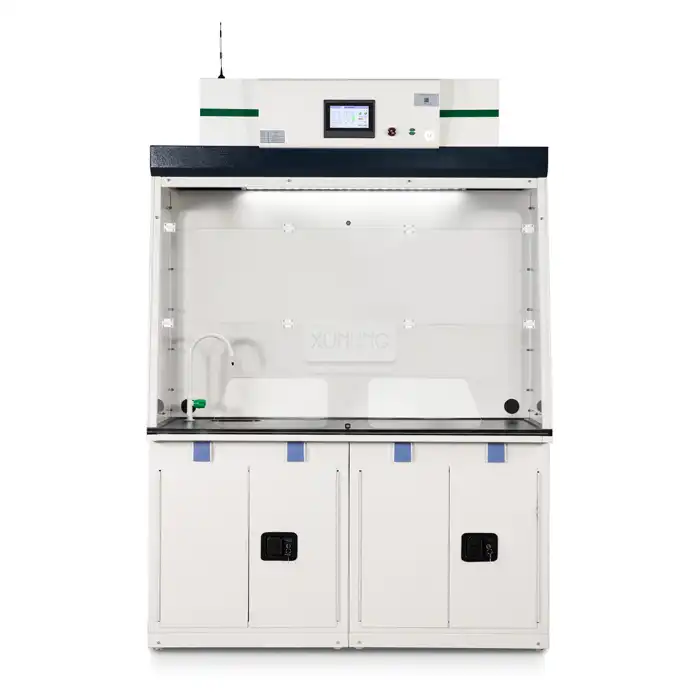
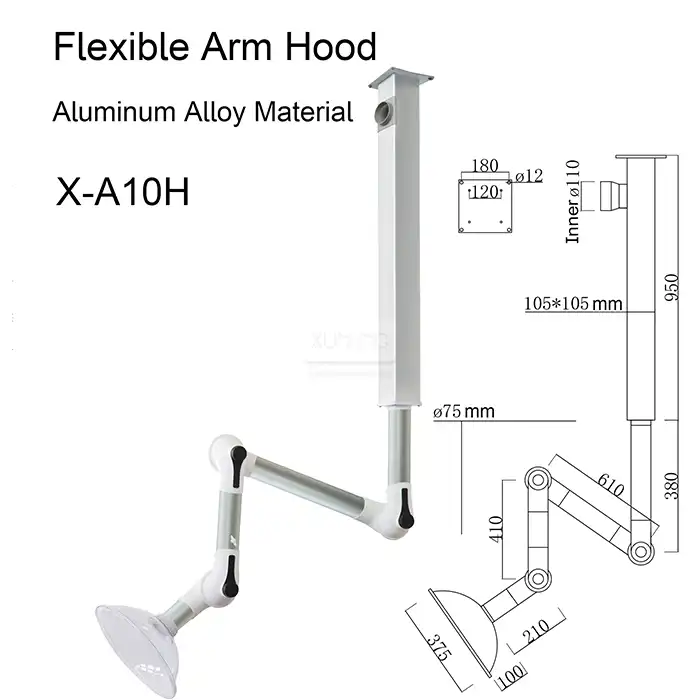
_1735392842145.webp)
